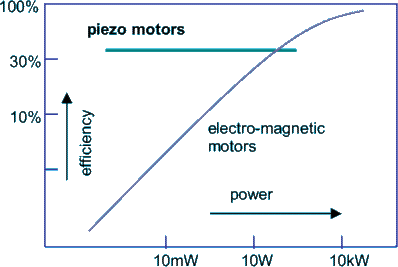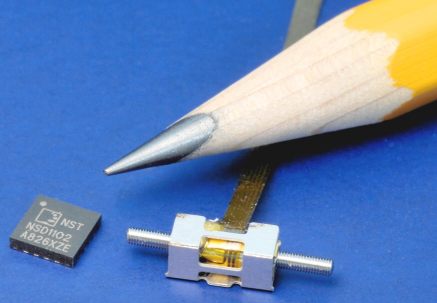Augmented Reality is more than Virtual Reality
Micro motors
Piezo motors made rapid progress recently, and are now a technology promising to provide all kinds of perfect static and dynamic adaptation for the optics of display glasses, at stunningly low weight and power consumption.
Electro-magnetic motors are good at high power applications, several kilowatts that is, where they can almost be 100% efficient, making possible train drives or car engines of magnificent performance. At low power however their effectiveness drops, literally borderless.
Piezo motors in turn, can deliver about 30% efficiency at literally any power scale.
Typical efficiency curves, and an example of a piezo motor* (Squiggle) together with it's driver IC These motors are very promising candidates for adaptive mechanisms (focus, fit) in near-eye displays. They are common as autofocus motors in compact cameras already.
Examples for these micro motors can be found at Physik Instrumente and at New Scale Technologies (Squiggle motor, picture).
' photo courtesy of New Scale Technologies
Artificial muscles have developed into another, promising micro motor technology. The first experiments with this technology date as early as 1880, when Conrad Roentgen could move a weight by applying voltage to a rubber band. Many electroactive materials have been discovered since, and the greatest progress has been made since 1990, leading to numerous, yet little-known applications. A good overview is found in [124]. The most interesting material for near-eye displays is electroactive polymer. Example figures for an elastic polymer lens with polymer actuators of this type are 10 mm opening diameter, 10ms response time, and 0.2W operating power (Optotune AG). This may give an impression of what is possible. Most interesting, however, is the specified lifetime of over 10,000,000 cycles. This is an entire year at approximately 3 seconds per cycle, or many years if we consider normal duty times and applications like focus or fit adaptation in a near-eye-display. Driving the electroactive polymer requires only simple electronics, and even though the power consumption appears a bit high at first glance, it is a very interesting technology in this context. For more information: NASA has a comprehensive website on electroactive polymers.
notes order
Copyright © 2006-2011 Rolf R. Hainich; all materials on this website are copyrighted.
Disclaimer: All proprietary names and product names mentioned are trademarks or registered trademarks of their respective owners. We do not imply that any of the technologies or ideas described or mentioned herein are free of patent or other rights of ourselves or others. We do also not take any responsibility or guarantee for the correctness or legal status of any information in this book or this website or any documents or links mentioned herein and do not encourage or recommend any use of it. You may use the information presented herein at your own risk and responsibility only. To the best of our knowledge and belief no trademark or copyright infringement exists in these materials. In the fiction part of the book, the sketches, and anything printed in special typefaces, names, companies, cities, and countries are used fictitiously for the purpose of illustrating examples, and any resemblance to actual persons, living or dead, organizations, business establishments, events, or locales is entirely coincidental. If you have any questions or objections, please contact us immediately. "We" in all above terms comprises the publisher as well as the author. If you intend to use any of the ideas mentioned in the book or this website, please do your own research and patent research and contact the author.

